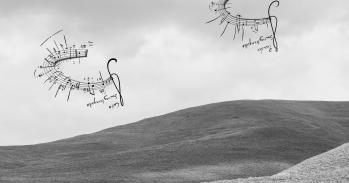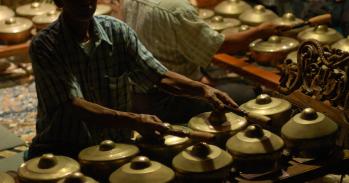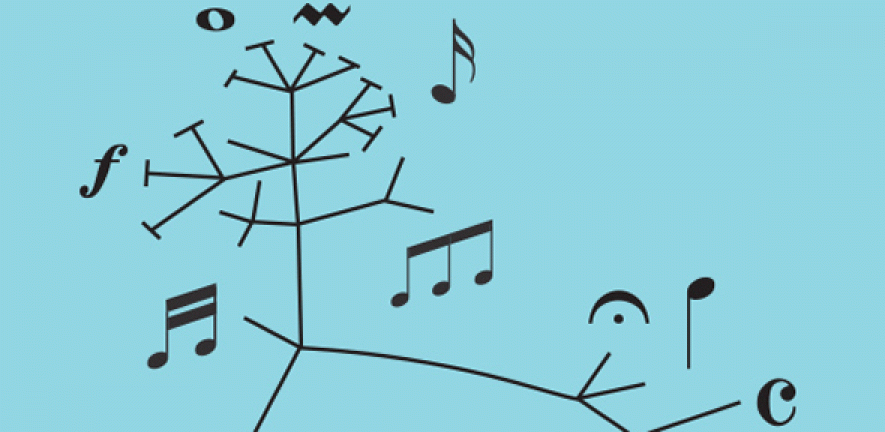
Modern scientific methods for mapping the evolution of species are being applied to centuries-old hand-copied music, providing new inspiration for how it is performed.
Modern scientific methods for mapping the evolution of species are being applied to centuries-old hand-copied music, providing new inspiration for how it is performed.
Evolutionary biologists use what are called ‘phylogenetic’ computational methods to compare the variations and work out the family tree. We realised we could also do this for pieces of literature
Christopher Howe
When Joseph Haydn completed his Symphony No. 95, shortly before its first performance in 1791, he forgot to include the oboes.
Although Haydn corrected himself — his hastily scrawled ‘flauto’ and ‘fagot’ in the margin are crossed out and replaced by ‘oboe’ — this snapshot of musical history serves as an evocative reminder of human fallibility. It’s impossible to get things right all of the time, and no less so than for activities like the writing or copying of complex musical scores.
In fact, ‘mistakes’ are quite common in hand-copied texts and music. Before the introduction of printing in the late 15th century, the only means of spreading written culture was for monks and other scribes to replicate manuscripts. For music, the challenges of printing musical notation meant that hand-copying continued well into the 17th and 18th centuries.
Unwittingly, the careless scribes — and those who deliberately made changes, perhaps to fit their own style or contemporary fashions, or to ‘improve’ on an earlier literary or musical composition — were helping future historians.
Each time a piece was copied, the change was propagated, and occasionally joined by a fresh change. Scholars use these variations to build family trees of “which was copied from which” that chart the relationship between pieces, helping them to ask questions about the authors, and the history and even the movement of specific texts across continents.
Two such scholars are Professor Christopher Howe and Dr Heather Windram. Yet, they are neither historians nor musicologists. They are biochemists.
Howe is known for his work on photosynthesis and the molecular evolution of photosynthetic microorganisms. It turns out that there are important similarities between the evolution of a species and the evolution of anything copied successively — texts, music, languages and even Turkmen carpets.
“What’s exciting is how many different things follow this pattern of copying with incorporation and propagation of changes. It’s just a fundamental principle about how the world is,” said Howe.
“During the evolution of species, mutations that occur when DNA is copied are passed on and, as species diverge, you see their DNA sequences become increasingly different. Evolutionary biologists use what are called ‘phylogenetic’ computational methods to compare the variations and work out the family tree. We realised we could also do this for pieces of literature.”
His first work in the 1990s was on Chaucer’s Canterbury Tales. He and his collaborators found that the technique worked well and, with Windram, he proposed a new name for the process — ‘phylomemetics’ — “well, it’s easier to say than phylogenetic analysis of non-biological sequence data,” said Howe.
Very little work, however, has been carried out on music, until now. In what they believe is the first test case of this type of analysis, Howe, Windram and one of the UK’s leading early keyboard players, Professor Terence Charlston from the Royal College of Music, have used their sophisticated algorithms to trace the relationships among a set of 16 copies of the Prelude in G by Orlando Gibbons from the 17th and 18th centuries.
“Although music is a form of written tradition, we needed to pick up on the relationships between pieces in a different way,” explained Windram. “Music is a guide for performance so I was very conscious that some changes might be silent — like two tied quavers changing to a crotchet — but others might be sufficient to change the sound of the music.”
In each of the 38 to 39 bars of music (depending on the source), Windram looked for changes in, for example, the note pattern, pitch and rhythm. She knew it should be possible — she had previously worked on a text that had 16,000 points of variation — and, with Charlston’s expertise in 17th-century music, she was able painstakingly to unpick the ‘mutant manuscripts’ and turn the variations into a numerical code.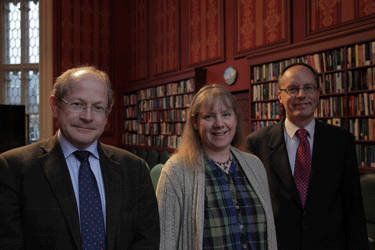
The researchers are quick to explain that no computer analysis can replace the expertise of the musicologist, who considers a mass of other information in addition to the patterns of variation, such as the cutting edge research carried out by Cambridge’s Faculty of Music to capture the creative history of music in the Online Chopin Variorum Edition. Where Howe’s team sees a significant benefit of its evolutionary approach is the ability to exploit a large amount of complex information and then carry out multiple consecutive analyses very rapidly.
"Once the coding is complete, you can focus on specific aspects of the music,” explained Windram. “You can run the analysis again and again, perhaps considering only certain categories of changes, or only looking at a section of the music at a time. It’s another tool in the musicologist’s toolbox, and how you interpret what you are seeing is aided by their expertise.”
Just as scholars of texts are using family relationships to ask broader questions about literature, the same can be carried out with music, as Charlston explained: “We can use these techniques to look at the corrections made by a single composer. Take Bach for instance. He was an inveterate reviser of his own music as he performed or taught it, and we can use these techniques to look at the creative process from notation to how it lives through performance.”
What pleases the researchers is how the tool could also help performance choices in the future: “Current musicology tends to look for a single correct version but, for a piece like Gibbons’s Prelude in G, there may be as many versions as there are people playing it at the time. My ideal would be to suggest to players today that within certain confines they should be seeking to make their own variants,” said Charlston.
For Howe, the excitement of the approach also lies in what it might do for evolutionary biology. “We can use this technique to identify if a copyist is copying from more than one piece at the same time — called contamination. There is a parallel in biology called lateral gene transfer where unrelated organisms exchange DNA. We now want to see if a program that can handle contamination in text can tell us something about lateral gene transfer in living organisms.”
The hope is that, like handwriting, musical notation will betray the hand of its composer or copyist. Analysis of variations in ‘mutant’ manuscripts — now carried out more quickly using the team’s phylomemetic tools — will help both to reconstruct musical history and to provide a tantalising glimpse of a creative process evolving.
Inset image, left to right: Christopher Howe, Heather Windram and Terence Charlston.
See and hear the visual and audible effects of the variants found between different sources of the same piece of Orlando Gibbon’s Prelude in G:
Example 1
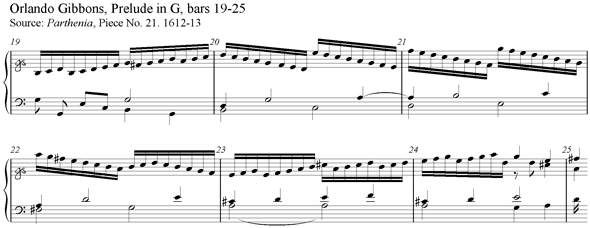
Example 2
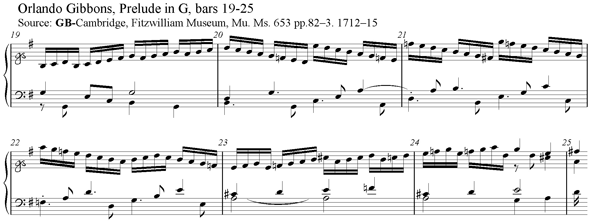
Both are from the same passage taken from the middle of Orlando Gibbon’s Prelude in G but from different sources; the variants occur in both hands. Example 1 is the original printed edition and Example 2 is a much later source held in the Fitzwilliam Museum in Cambridge. The right changes concern subtle alterations of pitch (often between f-sharp and f-natural) while the left hand bars differ mainly in rhythm and texture, but also with occasional changes in pitch. In addition to seeing the differences in music notation, you can hear each passage played on a 17th-century style harpsichord by Terence Charlston.
The sound files were recorded by Terence Charlston in February 2015 using a single-manual harpsichord by David Evans built in 2014, after an anonymous French original dated 1676. The instrument is tuned in 1/4 –comma meantone at a pitch of a1 = 415Hz.
Reconsidering the master of harpsichord
If you were a harpsichord player in the 17th century you almost certainly will have played Prelude in G by Orlando Gibbons (1583-1625). In fact, you are likely to have written out your own version, perhaps even ‘by ear’ while listening to your teacher.
Such was the esteem in which Orlando Gibbons was held that six of his compositions, including the Prelude in G, were included in the Parthenia – ‘the first musicke that ever was printed for the Virginalls [an instrument of the harpsichord family]’ in 1612-13, to commemorate the marriage of ‘the high and mighty Frederick, Elector Palatine of the Reine: and his betrothed Lady, Elizabeth the only daughter of my Lord the king [James I]’.
On one copy of the Prelude, now held in The Fitzwilliam Museum in Cambridge, an unknown hand has annotated it with the words ‘This is No 21 in the Parthenia & was a favorite Lesson(s) for upwards of a Hundred years’.
When Chris Howe, Heather Windram and Terence Charlston decided to try using their phylogenetic analytical techniques on music, Gibbons’s Prelude in G seemed a natural choice to make.
“Although it was available in print, few would have been able to afford to buy Parthenia, and yet almost all harpsichord players will have come across it,” explained Charlston. “It would have been copied and recopied by hand.”
The researchers were able to track down 16 copies in existence in museums and libraries across the UK and in Japan and the USA. Although further copies may yet come to light, 16 copies were enough to carry out the analysis as a proof of principle.
“We wanted to see if the variants segregated into ‘families’ with similar relationships using phylomemetics,” explained Windram. “Even in this test case we found two main families that corresponded to manuscripts copied earlier and later in the 17th century.”
The choice of Gibbons – who was a chorister in Cambridge’s King’s College between 1596 and 1598, where his brother was master of the choristers – has a personal resonance for Charlston. As Professor of Harpsichord at the Royal College of Music, and an internationally recognised performer, he knows Gibbons’s compositions well. “While he was famous in his own day, he isn’t widely known today,” he said. “This is a wonderful opportunity to reconsider him.”
The text in this work is licensed under a Creative Commons Licence. If you use this content on your site please link back to this page. For image rights, please see the credits associated with each individual image.




